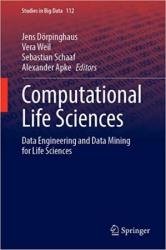 Название: Computational Life Sciences: Data Engineering and Data Mining for Life Sciences
Название: Computational Life Sciences: Data Engineering and Data Mining for Life SciencesАвтор: Jens Dorpinghaus, Vera Weil, Sebastian Schaaf
Издательство: Springer
Серия: Studies in Big Data
Год: 2023
Страниц: 593
Язык: английский
Формат: pdf (true)
Размер: 19.2 MB
This book broadly covers the given spectrum of disciplines in Computational Life Sciences, transforming it into a strong helping hand for teachers, students, practitioners and researchers. In Life Sciences, problem-solving and data analysis often depend on biological expertise combined with technical skills in order to generate, manage and efficiently analyse Big Data. These technical skills can easily be enhanced by good theoretical foundations, developed from well-chosen practical examples and inspiring new strategies. This is the innovative approach of Computational Life Sciences-Data Engineering and Data Mining for Life Sciences: We present basic concepts, advanced topics and emerging technologies, introduce algorithm design and programming principles, address data mining and knowledge discovery as well as applications arising from real projects. Chapters are largely independent and often flanked by illustrative examples and practical advise.
Every day and world-wide, the field of life sciences is changing in terms of software, algorithms, file formats and much more. Regarding this, together with the already mentioned issue of handling a great amount of rapidly increasing data, it is nearly unavoidable to develop and apply new, efficient, robust and thus reliable heuristics and algorithms. In other words, a lot of problems in life sciences and bioinformatics have to be approached with algorithmic solutions, presuming technical understanding and, of course, biological expertise. This applies to students, researchers and practicioners to the same extent. And here lies the entry point of our book.
The purpose of this book is to offer you theoretical knowledge as well as practical advice on diverse yet fundamental topics of computational life sciences. This encloses at least a sketch (and often much more than this) of the theoretical foundations of a specific field as well as the thereof evolving practical aspects. In some cases, this leads up to the presentation of an (implemented) solution found for a problem that arose in a specific application. Hence, every chapter of this book is either of high practical relevance or of great scientific interest, or both. If you are interested in Data Science and Life Sciences in general, of if you want to consolidate your knowledge in these topics, of if you are interested in applications and evolving technologies in this field or if you just need an inspiration in order to approach your own problem at hand, we believe that this book offers you a strong helping hand. Or, to make it short: We believe that students, junior and senior researchers benefit from this book as well as teachers and practitioners.
This book is divided into five parts. The first part, Solving Problems in Life Sciences: On Programming Languages and Basic Concepts, offers foundations on different topics. Nowadays, issues being bound to a certain language are rare, hence the first chapter considers the most common programming languages used in the Life Sciences. It closes with a short explanation why we chose Java to play a main role in most of our examples. The first chapter is followed by an introduction to the programming language Java, including information of using collaborative tools like git. This introduction offers a quick start guide to Java, and comes in hand with the third chapter, Basic Data Processing. Amongst other topics, common data structures and their usage as well as apects of the object-orientied programming paradigm are introduced. The part closes with the chapter Algorithm Design, in which we consider the modeling of real world problems as well as fundamental algorithmic principles.
The second part, Data Mining and Knowledge Discovery, starts with an introductory chapter on the management of data and knowledge. This is followed by the chapter on databases and how the contained information can be structured using knowledge graphs. Applied statistics and AI approaches with regard to the applications in life sciences and medicine are the core elements of the third chapter. It closes with a chapter on longitudinal data, that is, roughly speaking, data repeatedly collected over an extended period of time.
The third part on Distibuted Computing and Clouds offers insights on computational grids as well as on cloud computing. Both of these chapters are flanked by examples emerging from applications in the life sciences. The part closes with a chapter on standards which help to create interoperable solutions that are then able to interact with other solutions using the same standards.
Working and doing research in the life sciences often requires knowledge in at least one of the following topics: graphs, optimiziation, image processing and sequence analysis. Hence, in the fourth part, Advanced Topics in Computational Life Sciences, starts with a chapter on graphs and how to implement and use them with Java. It is followed by a chapter in which the fields of linear programs and combinatorial optimization are illuminated. Images play a crucial role in the life sciences and medicine, hence we dedicated the third chapter to image processing and image manipulation.
Скачать Computational Life Sciences: Data Engineering and Data Mining for Life Sciences